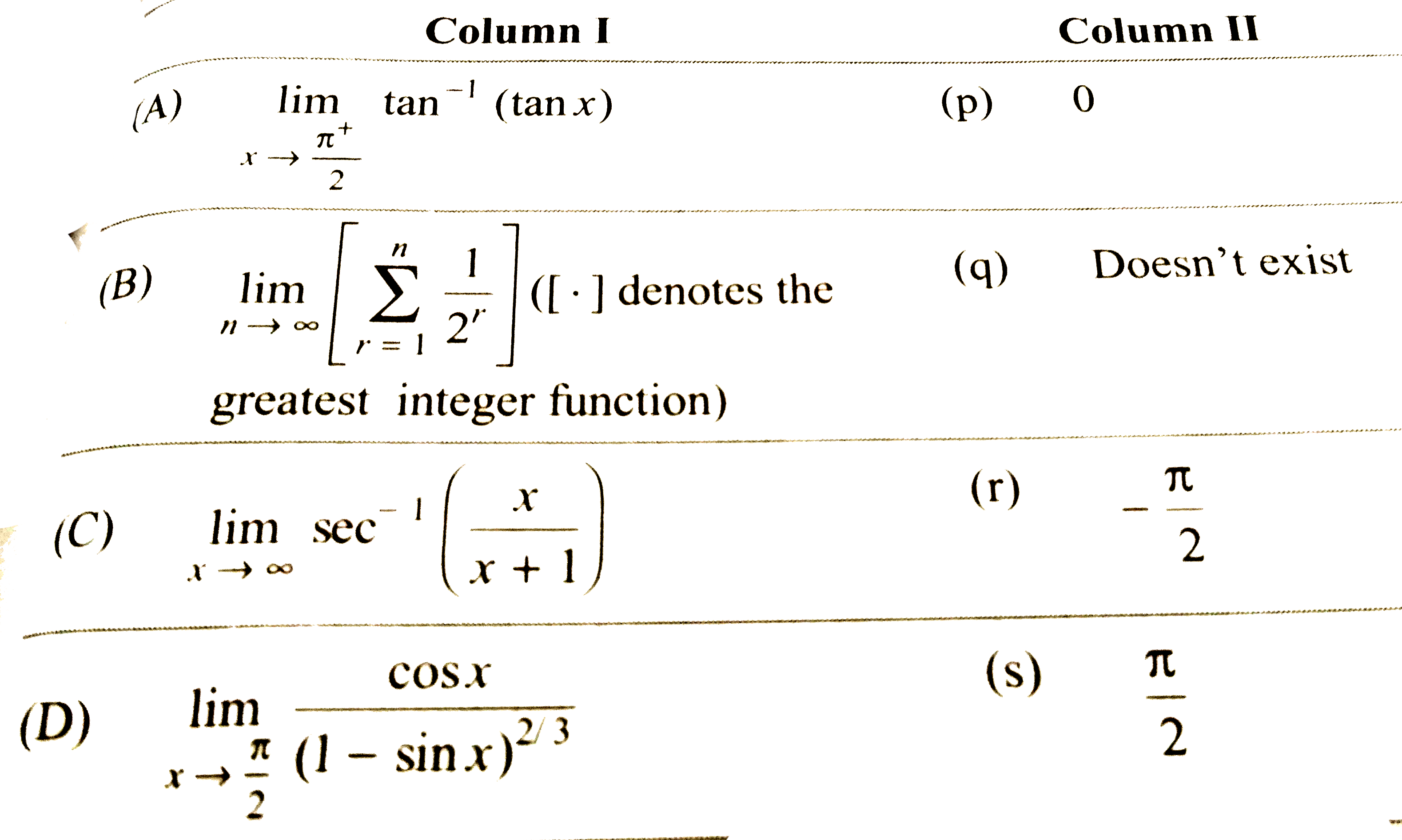If limx→af(x)=1 and limx→ag(x)=∞ then limx→a{f(x)}g(x)=elimx→a(f(x)−1)g(x) limx→0(x−1+cosxx)1x is equal to Solution in Punjabi
(a)e1/2
(b)e−1/2
(c)e1
(d)1e
The correct Answer is:B
Step by step video, text & image solution for If lim_(xtoa)f(x)=1 and lim_(xtoa)g(x)=oo then lim_(xtoa){f(x)}^(g(x))=e^(lim_(xtoa)(f(x)-1)g(x)) lim_(xto0)((x-1+cosx)/x)^(1/x) is equal to by Maths experts to help you in doubts & scoring excellent marks in Class 12 exams.
Topper's Solved these Questions
- BOOK - ARIHANT MATHSCHAPTER - LIMITSEXERCISE - Exercise (Matching Type Questions)3videos
LIMITS
- BOOK - ARIHANT MATHSCHAPTER - LIMITSEXERCISE - MATCHING TYPE QUESTIONS1videos
LIMITS
- BOOK - ARIHANT MATHSCHAPTER - LIMITSEXERCISE - Exercise (More Than One Correct Option Type Questions)15videos
LIMITS
- BOOK - ARIHANT MATHSCHAPTER - INVERSE TRIGONOMETRIC FUNCTIONSEXERCISE - Exercise (Questions Asked In Previous 13 Years Exam)8videos
INVERSE TRIGONOMETRIC FUNCTIONS
- BOOK - ARIHANT MATHSCHAPTER - LOGARITHM AND THEIR PROPERTIESEXERCISE - Exercise (Questions Asked In Previous 13 Years Exam)4videos
LOGARITHM AND THEIR PROPERTIES
Similar Questions
Match the statements of Column I with values of Column II.
 02:40View Solution
02:40View SolutionFind dydxif1−y=x
01:30View SolutionIf limx→∞4x(π4−tan−1(x+1x+2))=y2+4y+5 then y can be equal to
02:06View SolutionIf α=3sin−1(611andβ=3cos−1(49), where the inverse trigonometric functions take only the principal values, then the correct options (s) is (are)
02:43View SolutionIn Which quadrant Point (−2,−3) will be lie.
02:48View SolutionIf limx→a[f(x)+g(x)]=2 and limx→a[f(x)−g(x)]=1, then find the value of limx→af(x)g(x).
06:10View SolutionConsider the following statements :
1. If limx→af(x)andlimx→ag(x) both exist, then limx→a{f(x)g(x)} exists.
2. If limx→a{f(x)g(x)} exists, then both limx→af(x)andlimx→ag(x) must exist.
Which of the above statements is /are correct?02:53View SolutionIf limx→af(x)=1 and limx→ag(x)=∞ then limx→a{f(x)}g(x)=elimx→a(f(x)−1)xg(x)
limx→0(sinxx)sinxx−sinx is equal to03:34View SolutionIf limx→af(x)=1 and limx→ag(x)=∞ then limx→a{f(x)}g(x)=elimx→a(f(x)−1)g(x) limx→0(x−1+cosxx)1x is equal to
04:45View SolutionIf limx→af(x)=1 and limx→ag(x)=∞ then limx→a{f(x)}g(x)=elimx→a(f(x)−1)g(x) limx→0(ax+bx+cx3)2x is equal to
03:57View SolutionIf limx→a+f(x)=l=limx→a−g(x) and limx→a−f(x)=m=limx→a+g(x), the function f(x).g(x) is
03:58View SolutionIf limx→a{f(x)g(x)} exists, then
03:13View SolutionIf limx→a[f(x)+g(x)]=2 and limx→a[f(x)−g(x)]=1, then find the value of limx→af(x)g(x).
02:53View SolutionIf limx→af(x)=1 and limx→ag(x)=∞ then limx→a{f(x)}g(x)=elimx→a(f(x)−1)g(x)
limx→0(sinxx)sinxx−sinx is equal to02:53View SolutionIf limx→af(x)=1 and limx→ag(x)=∞ then limx→a{f(x)}g(x)=elimx→a(f(x)−1)g(x) limx→0(x−1+cosxx)1x is equal to
02:18View SolutionIf limx→af(x)=1 and limx→ag(x)=∞ then limx→a{f(x)}g(x)=elimx→a(f(x)−1)g(x) limx→0(ax+bx+cx3)2x is equal to
02:13View Solution

